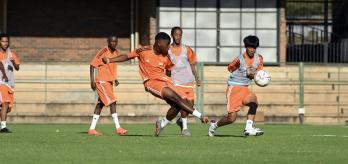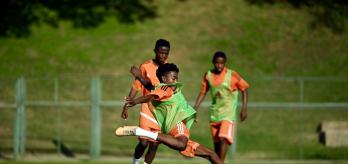Methodology
The intention: What is practised?
This attack v. defence game focuses on creating goalscoring chances by taking on an opponent in a one-on-one scenario or by linking up with team-mates in a three-player combination when the move is initiated in the wide channel.The exercise is aimed at player and unit level, focusing on aspects such as quick thinking, decision-making, aggressive on-the-ball actions and creating goalscoring chances from various positions when operating as a wide player. Players must prioritise driving the ball inside and towards goal while being able to adapt quickly and to change approach if the one-on-one scenario does not offer the desired outcome. When combining, attacking players must focus on their movement and the timing of their runs to pull defenders out of position so as to enable them to attack in behind the wide areas.
The scale: For whom is this relevant?
This game revolves around the player scale and focuses on outplaying defenders in a wide channel using aggressive direct play and performing quick actions. The exercise is particularly relevant to players who attack down one side of the pitch, primarily wingers who look to come inside to receive the ball. From their starting position in the wide channel, the player is tasked with creating an attack. Later on in the drill, other players, such as midfielders and full-backs, are added to the exercise to provide further options when creating attacks from a position in the wide channel. The exercise is position-specific, with players asked to perform specific roles in the one-on-one scenario and the 3v2 situation.
The practice type: How is the practice designed?
This exercise involves an attack v. defence game that is played inside a wide channel that runs from close to the halfway line towards goal. The channel is designed to create a realistic starting point and angle towards goal when building an attack after receiving the ball infield. The mini-goal provides the winger with an alternative attacking option should they be forced wide and helps them to become more flexible to going either inside or outside. The opposing defender’s starting position replicates a real-game scenario, as does the angle towards goal, whilst the other mini-goal gives the defender an objective once they have won the ball.
Session plan
Organisation
-
Set up a half-size pitch with a full-size goal at one end and position a goalkeeper in the goal.
-
Mark out a 20m x 45m channel that runs from 1 of the corners of the goal area towards the halfway line.
-
Position a mini-goal a short distance from the same corner of the goal area in the direction of and facing the nearest touchline.
-
Place a mini-goal at the midpoint of the line that marks the end of the channel closest to the halfway line and facing towards the penalty area.
-
Place a cone close to the point where the penalty arc intersects with the penalty area (defenders’ station).
-
Split the group into 2 teams of 4 (attack v. defence).
-
Place 2 attacking players (oranges) at the cone that marks the end of the channel closest to the halfway line and that is parallel to the defenders’ station (passers’ station).
-
Position the other 2 attacking players facing towards the full-size goal and approximately a third of the way along the side of the channel closest to the touchline (attackers’ station).
-
Place 1 defender at the defenders’ station, with the remaining 3 defenders positioned beside the full-size goal.
Explanation
-
The exercise begins with the first player at the passers’ station dribbling the ball a short distance towards the attackers’ station before playing a pass to the first attacker, who pulls away from their station to receive the pass.
-
The attacker, who is closed down by the defender positioned at the defenders’ station as soon as the passer plays the ball into the attacker, tries to take on the defender and finish in the full-size goal.
-
If the attacker is forced wide, they must try to pass the ball into the mini-goal positioned a short distance from the edge of the goal area.
-
The defender’s objective is to defend the full-size goal and to force the attacker wide.
-
If the defender wins the ball, they try to score in the mini-goal positioned at the end of the channel closest to the halfway line.
Variation
-
The exercise progresses into a 3v2. For this variation, a second mini-goal is placed on the line that marks the end of the channel.
Key coaching points
Roles of coaches
-
First coach: leads the session and takes up various positions around the exercise area, encouraging both sets of players throughout.
-
Second coach: offers the attacking players encouragement from their position along one side of the channel.
-
Third coach: takes up a position beside the defenders and offers them pointers on adopting the right body shape when defending in a one-on-one scenario.













































